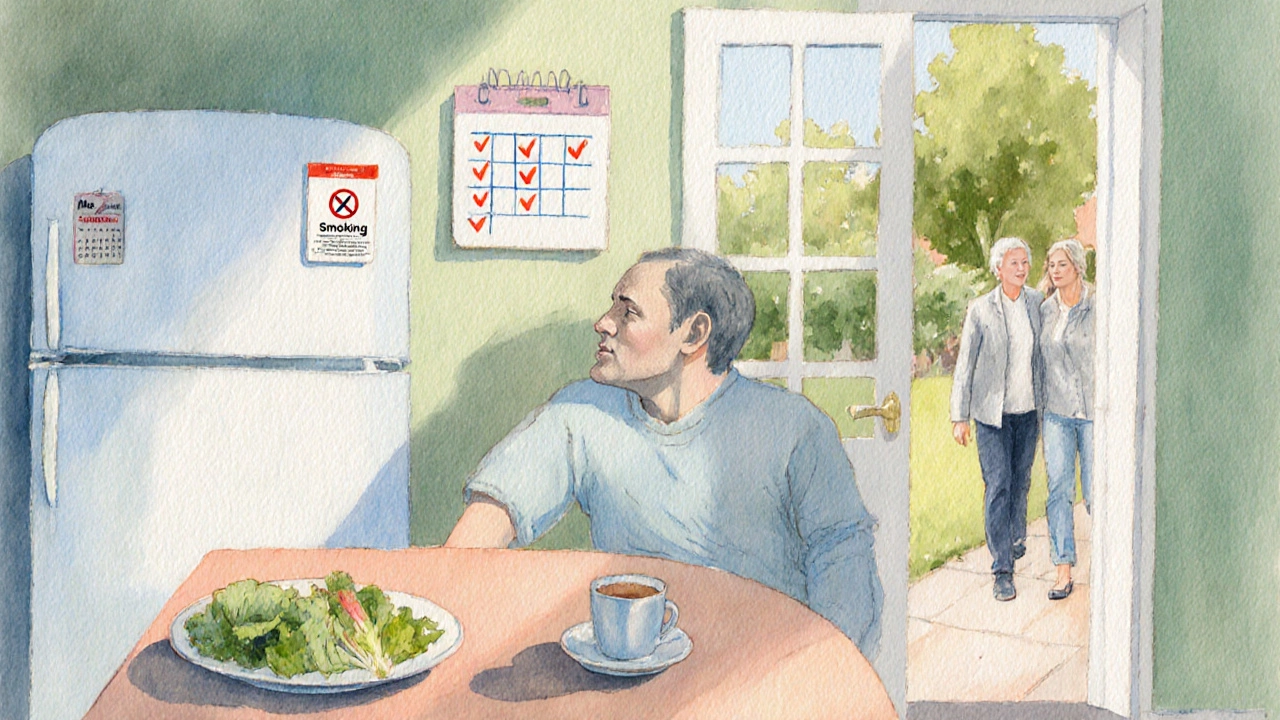
- Oct, 19 2025
- 0
People often hear the phrase “open heart surgery” and picture a risky, life‑threatening drama. The truth is more nuanced: modern medicine has turned many of those high‑risk operations into routine procedures with impressive survival numbers. If you’re wondering just how rare it is to walk out of the operating room alive, this guide breaks down the data, the factors that push survival up or down, and what you can do to boost your odds.
Key Takeaways
- Overall 30‑day survival after open heart surgery in high‑volume centers exceeds 95 % in most Western countries.
- Age, emergency status, and comorbidities are the biggest predictors of postoperative mortality.
- Choosing a hospital that performs >200 open heart procedures a year can improve survival by 2‑4 %.
- Pre‑surgical optimisation-quitting smoking, controlling diabetes, and cardiac rehab-cuts risk dramatically.
- Survival rates differ by procedure: coronary artery bypass grafting (CABG) averages 96 % while complex valve repairs sit around 92 %.
Below you’ll find a step‑by‑step look at how survival is measured, the latest numbers, and the practical steps you can take if you or a loved one faces an operation.
What is Open Heart Surgery?
Open heart surgery is a surgical procedure where the chest is opened and the heart is temporarily stopped or supported while doctors repair or replace damaged structures. The surgeon typically uses a heart‑lung machine-also called cardiopulmonary bypass-to take over circulation, allowing a blood‑free field to work on the heart. Common types include coronary artery bypass grafting (CABG), where blocked arteries are rerouted, and aortic valve replacement, which swaps a faulty valve for a prosthetic one.
How Are Survival Rates Measured?
Survival is usually reported as a survival rate, the percentage of patients alive at a specific time point after surgery-most commonly 30 days (short‑term) and 1 year (mid‑term). Data come from national registries (e.g., the Society of Thoracic Surgeons in the U.S.) and large hospital databases. Researchers adjust for age, gender, and health status to produce risk‑adjusted figures that reflect the procedure itself rather than patient mix.
Current Survival Statistics
Across the United States, Europe, and parts of Asia, the open heart surgery survival numbers are encouraging:
- Overall 30‑day mortality: 2-4 % in high‑volume centers, translating to a 96-98 % survival rate.
- Age breakdown:
- Patients < 55 years: 1.5 % mortality (98.5 % survive).
- Patients 55-75 years: 3 % mortality (97 % survive).
- Patients > 75 years: 6-8 % mortality (92-94 % survive).
- Procedure type (from 2023-2025 data):
- CABG: 96 % 30‑day survival.
- Single‑valve replacement: 94 %.
- Complex multi‑valve or aortic root repair: 90-92 %.
Emerging data from Asia’s top cardiac centers show similar trends, though some low‑resource hospitals still report 30‑day mortality above 10 %, underscoring the importance of hospital quality.

Factors That Influence Survival
Survival isn’t a single‑number lottery; many variables tilt the odds.
Patient‑Related Risk Factors
Age, chronic kidney disease, diabetes, chronic obstructive pulmonary disease (COPD), and prior strokes are the strongest predictors of postoperative mortality. A 2024 STS risk model assigns each factor a score; the higher the total, the higher the expected mortality.
Procedure‑Related Complexity
Emergency operations-such as surgery to repair a ruptured aorta-carry a 2-3× higher death risk than elective cases. Similarly, re‑operations (going back into the chest after a prior surgery) increase risk because scar tissue makes the operation harder.
Hospital Volume and Surgeon Experience
Hospitals that perform more than 200 open heart surgeries per year consistently report lower mortality. The difference is about 2-4 % compared with low‑volume centers (< 50 cases/year). Surgeon experience matters, too; teams that have worked together for years tend to have smoother bypass times and fewer complications.
Post‑Operative Care
Intensive care unit (ICU) staffing ratios, early extubation protocols, and aggressive infection control have all been linked to better outcomes. Centers with dedicated cardiac ICU teams see the biggest gains.
Improving Your Odds: Practical Steps
If you or a family member faces open heart surgery, here are evidence‑backed actions you can take.
- Ask about the center’s volume. A hospital that logs >200 cases annually typically has better outcomes.
- Review surgeon credentials. Look for board certification in cardiothoracic surgery and years of experience with the specific procedure.
- Optimize health before surgery. Quit smoking at least 4 weeks ahead, control blood sugar, and manage cholesterol. A pre‑operative cardiac rehab program can lower mortality by up to 30 %.
- Discuss medication adjustments. Certain blood thinners need to be paused, while beta‑blockers are often continued to stabilize heart rhythm.
- Plan for post‑operative support. Arrange a caregiver for the first 48‑72 hours, and schedule follow‑up visits promptly.
Common Misconceptions
Myth 1: Open heart surgery is a death sentence. Modern data show a 95 %+ survival rate in reputable centers, far from “rare” survival.
Myth 2: Age alone decides the outcome. While age is a risk factor, a healthy 78‑year‑old with good kidney function can do better than a 55‑year‑old with uncontrolled diabetes.
Myth 3: All hospitals are the same. Outcomes vary dramatically based on volume, staff expertise, and postoperative protocols.

Comparison of Survival by Procedure Type
| Procedure | Average 30‑Day Survival | Typical Patient Age | Key Risk Modifiers |
|---|---|---|---|
| Coronary artery bypass grafting (CABG) | 96 % | 61 years | Diabetes, left main disease |
| Single‑valve replacement (aortic or mitral) | 94 % | 68 years | Renal insufficiency, emergent status |
| Complex multi‑valve or aortic root repair | 91 % | 72 years | Re‑operation, connective tissue disorder |
| Emergency aortic dissection repair | 85 % | 54 years | Marfan syndrome, delayed presentation |
Quick Checklist Before Your Surgery
- Confirm hospital performs >200 open heart surgeries/year.
- Verify surgeon’s board certification and years of experience.
- Complete a pre‑operative cardiac rehab program.
- Stop smoking at least 4 weeks before the operation.
- Arrange post‑operative caregiving for the first 72 hours.
Frequently Asked Questions
What is the overall chance of surviving open heart surgery?
In high‑volume hospitals, about 96‑98 % of patients survive the first 30 days after an elective open heart operation. Emergency cases have lower rates, but even then, many patients make it through.
Does age dramatically lower survival odds?
Age is a factor, but comorbidities matter more. A healthy 80‑year‑old can have a better outlook than a 60‑year‑old with uncontrolled diabetes and kidney disease.
How does hospital volume affect outcomes?
Centers that perform over 200 open heart cases a year typically see a 2‑4 % lower mortality rate compared to low‑volume hospitals. The difference is linked to experienced teams and refined postoperative protocols.
Can I improve my chances before the operation?
Yes. Quitting smoking, controlling blood sugar, losing excess weight, and completing a short cardiac rehab program can cut the risk of complications by 20‑30 %.
What are the biggest risks after surgery?
The most common complications are infections, stroke, kidney injury, and arrhythmias. Early mobilization and strict infection control reduce these risks.
Bottom line: surviving open heart surgery is far from a miracle-it's the expected outcome for the majority of patients in quality centers. By understanding the numbers, the risk drivers, and the steps you can control, you turn a scary phrase into a manageable, data‑driven decision.
Nikhil Verma
I'm a dedicated physician with a passion for exploring the intricacies of medicine, focusing on the unique healthcare challenges in India. I spend much of my spare time writing articles aimed at improving public understanding of health issues. Balancing my clinical practice and writing allows me to reach a wider audience, sharing insights and fostering a deeper appreciation for medical advancements. I derive immense satisfaction from both treating patients and engaging with readers through my writing.